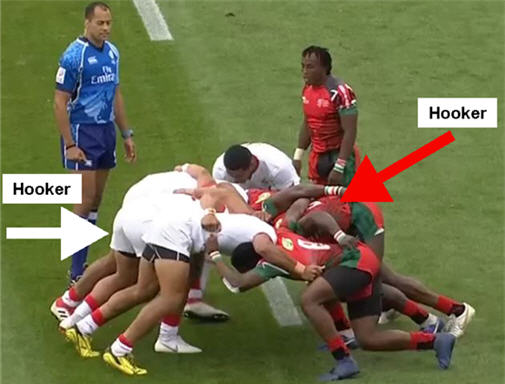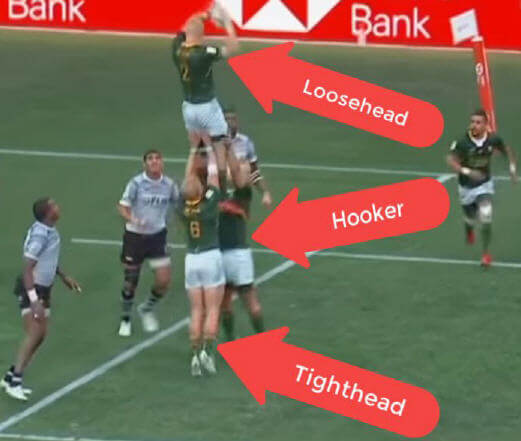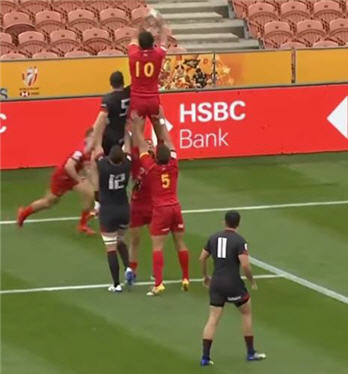This article looks at the position and role of hooker in sevens rugby.
I’ll show you what hookers do in the scrum and lineout in a game of sevens. And you’ll also see some outrageous skills in open play!
What Is A Hooker In Rugby Sevens?
The hooker in a sevens rugby team is one of the three forwards on the field.
Hookers are primarily defined by their position and role in the scrum. They bind between the two props and strike the ball backward out of the scrum.
Unlike fifteen-a-side rugby, hookers in sevens often lift in the lineout.
In contrast, hookers in the fifteens version of the sport almost exclusively throw the ball into lineouts.
You will still see sevens hookers throwing, but it is becoming rarer at international level. I’ll discuss lineouts in a later section.
What Does The Hooker Do In The Scrum In Sevens Rugby?
In sevens rugby, three forwards from the two teams line up on each side of the scrum.
The hooker is in the middle of the row. He binds an arm around the prop forwards on either side of him. You can also check out our article on the role of the loosehead and tighthead props in sevens rugby.

The hooker has several tasks in the scrum.
The props tend to focus on pushing, while the hooker keeps them steady and straight.
Sevens teams usually want to get the ball out of the scrum as quickly as possible, so may not put much effort into driving forward.
However, pushing hard is also a tactic that can get an edge. If that’s the call, the hooker will push in unison with the props.
Striking the ball
“Striking” the ball is rugby terminology for using a foot to tap the ball backward out of the scrum. It’s also known as “hooking” the ball.
This is usually done by the hooker (although that’s not mandatory).
The movement is more of a tap than a strike because players don’t want the ball to shoot backward too hard. The scrum-half needs to pick up the ball, and a hard strike will probably lead to a fumble.
Examples of striking
The video in this section shows you two quite different techniques from the same match. I’ll describe what’s going on now before you watch it.
Kenya was playing Tonga in the New Zealand Hamilton 7s in 2019. This is part of the World Series, and the match was the challenge cup final.
The Tongan hooker gently taps the ball with the foot nearest the put-in. It may be a little difficult to see even though I’ve slowed it right down in the video.
In stark contrast, the Kenyan hooker uses the foot furthest from the put-in. He uses a gentle sweeping motion to push the ball with the instep.
This is probably the better technique! There is more control of the ball and its direction.
After the scrum
When the ball comes out of the scrum, the props may continue to grapple with each other for a brief period.
But hookers get out of the scrum as quickly as possible, regardless of who is in possession.
The hooker on the attacking team runs to support the half-back.
The hooker on the defending team moves quickly to defend at the side of where the scrum was taken.
The defending hooker may move left while his scrumhalf moves right. They’ll agree on the directions before the scrum packs down!
Does The Hooker Throw Into The Lineout In Rugby Sevens?
If you watch fifteen-a-side rugby, then you’ll know that the hooker almost always throws the ball into the lineout.
The only exceptions I see are when the hooker has been sin-binned. A prop often steps up for the role – especially if they played hooker at youth level, but that may be a long time ago.
The results can be comically bad. But I digress. Let’s get back to sevens rugby.
Although you’ll see hookers throwing in sevens, nowadays the throws are more likely to be taken by a halfback. The player throws in the ball and then runs to receive it from the catcher.
What happens next is why hookers are less likely to take this role.
The half-back receives the ball and then either runs or passes to set up the attack. With the opposition forwards bunched on the near side of the field, the most effective move may be a long pass to the center of the field.
This requires excellent passing skills of either hand. That’s why half-backs are more likely now to throw in the ball, as they are usually the best passers in the squad.
However, I don’t want to suggest that hookers can’t pass. Here’s an outrageous piece of skill by international Fijian sevens hooker Kalione Nasoko.
What Does The Hooker Do In the Lineout In Sevens Rugby?
If a sevens hooker doesn’t throw in the ball, then what do they actually do in a lineout?
This depends on how big and heavy they are. The larger players will often assist in lifting the jumping player.
Here’s a picture from the Springboks playing Fiji in a sevens tournament. The loosehead prop jumps to catch the ball, while his tighthead teammate supports the lift along with the hooker.

Lighter hookers can be very effective jumpers.
In the Hamiton 7s tournament in 2019, one of the Spanish hookers was a regular jumper in the lineout.

Can Hookers From Fifteens Rugby Also Play Sevens?
Modern-day hookers at international level fifteens rugby are quite different to their forebears.
They are expected to be more dynamic and have more pace. Props sometimes grumble about their hooker teammates hanging out on the wing!
Could the likes of Dane Coles (speedy All Blacks hooker) have cut it at a younger age on the sevens circuit? I think so.
However, amateur club hookers are often a more…umm…traditional shape. And as scrums are more important in the fifteens game, they can rightfully say they need the extra ballast.
Fifteens hookers can certainly play sevens in social tournaments, but I’ve not seen a player convert at international level.
What Number Does A Hooker Wear In Sevens?
You may know that the starting hooker in fifteen-a-side matches wears the number two.
Sevens rugby doesn’t impose specific numbers to positions on the field. So you’ll see players at all positions wearing two in a tournament.
Hookers in sevens don’t wear a particular number on their shirts.
Other Positions
The front row may not like to admit, but the backs are also very important in 7s!
We have an overview of all the positions and roles in the 7s game. It links out to in-depth articles on each position with pictures and videos that showcase the skills.